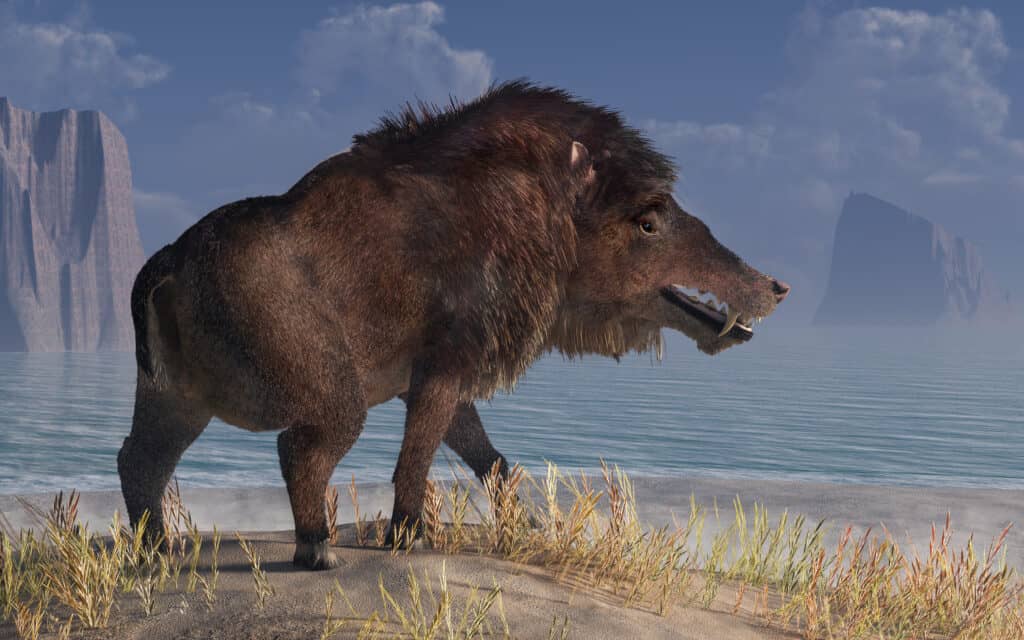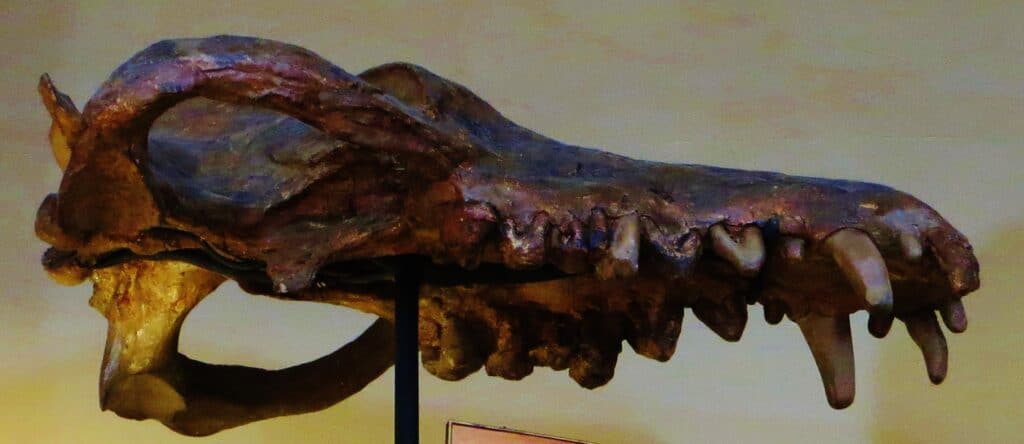Over the course of the earth’s history, a lot of animals once called the blue planet home. Some of the largest animals today tower over humans. Bears, tigers, and other big cats are the planet’s biggest carnivorous land predators. Being billions of years old, species have existed in the planet’s lifetime that make even the biggest animals today look tiny. Here you will discover the ancient Mongolian predator that was as tall as a horse and weighed a ton.
The Andrewsarchus is the largest land-walking carnivorous mammal to ever exist, but what exactly do we know about this ancient beast? Thanks to fossils left behind by animals, and amazing paleontologists that study them, we can look into the past. While the Andrewsarchus is extinct, there is still a lot to learn about this giant predator that lived millions of years ago.
What is the Andrewsarchus?

Recent studies classified Andrewsarchus as an artiodactyl.
©Daniel Eskridge/Shutterstock.com
The Andrewsarchus is an extinct genus of carnivorous animals that lived in the Eocene epoch period. Andrewsarchus mongoliensis is the only species in its genus. This animal was a mammal, and recent studies classify this species as an artiodactyl. It is a member of the clade Centancodontamorpha, which closely relates to animals like hippos, dolphins, and whales.
Today the Andrewsarchus is only known by left behind fossil evidence. Research has shown the Andrewsarhcus was as tall as a horse and weighed more than a ton. Its size made it one of the largest carnivores that roamed the earth.
Discovery of the Andrewsarchus
Currently, the Andrewsarchus is only known by one fossil, which was discovered in the spring of 1923. In an expedition led by paleontologist Roy Chapman Andrews, a large 3-foot skull was found by expedition member Kan Chuen Pao.
The American Museum of Natural History in New York sponsored the expedition. The name of the Andrewsarchus mongoliensis is in reference to the expedition leader, and where the fossil was found, Inner Mongolia.
At its discovery, expedition members believed the large skull of the Andrewsarchus belonged to that an extinct pig. After being studied by a museum, further research showed the fossil was a new species. When first classified, the Andrewsarchus was put in the category of mesonychid and had the title of “the giant mesonychid of Mongolia.”
Today the Andrewsarchus is classified as an artiodactyl. With further research and a chance for more possible fossil discoveries, there is a lot to be uncovered about this ancient giant.
Size and Appearance

The Andrewsarchus is only known by one fossil.
©Ghedoghedo, CC BY-SA 3.0 <https://creativecommons.org/licenses/by-sa/3.0>, via Wikimedia Commons – License
The skull of the Andrewsarchus is the only known fossil, and it was around 2.8 ft, (86 cm) long, and 1.8 ft (56 cm) wide. Their mouth was filled with large sharp teeth and flatter cheek teeth. Using other similar fossils experts are able to estimate the size of this animal. It is estimated the Andrewsarchus stood 6 feet tall and had a length of 12 feet.
While it is not known how this large mammal looks, most depictions show them looking similar to furry pigs. If this mammal was the estimated size, that would make it the largest land mammal carnivore. Andrewsarchus is estimated to have a weight between 1,700 lbs to 2,200 lbs. The only carnivorous mammal that is able to rival them in size is the American short-faced bear which stood upright over 11 feet and weighed up to 2,500 lbs.
What Did the Andrewsarchus Eat?
Debates have occurred about what this animal could have eaten, but it is most likely that they were carnivores. Experts believed that the Andresarchus was both a scavenger and predator, eating the food most available to them. Being as tall as a horse the Andrewsarchus was likely an apex predator and had the ability to take out most animals they attacked.
Habitat and Time Period of the Andrewsarchus
Inner Mongolia in China is where the only fossil of this species was found. Andrewsarchus lived in the late Eocene epoch of the Paleogene period. During this period subtropical and temperate forests were abundant. It is likely that this species died off during the Eocene epoch 36 million years ago, but it is not yet known what caused this animal’s disappearance. Earth’s changing climate is one theory on what killed megafauna like the Andrewsarchus.
Up Next:
Love dinosaurs and ancient species? Check out these other amazing articles about animals from millions of years ago:
- Discover the Ancient Predator That Came Before the Velociraptor
- 11 Ancient Mammals that Lived Alongside Dinosaurs
- This Ancient Animal Wasn’t Human, But It Was Close
- 9 Ancient Dinosaurs That Were Like Giant Alligators
The photo featured at the top of this post is © Boris Dimitrov, CC BY-SA 3.0
Sources
- Skull of Gigantic Beast, Available here: https://www.amnh.org/explore/news-blogs/on-exhibit-posts/andrewsarchus
- Andrewsarchus, Available here: https://en.wikipedia.org/wiki/Andrewsarchus
- Andrewsarchus , Available here: http://www.prehistoric-wildlife.com/species/a/andrewsarchus.html
Thank you for reading! Have some feedback for us? Contact the AZ Animals editorial team.






